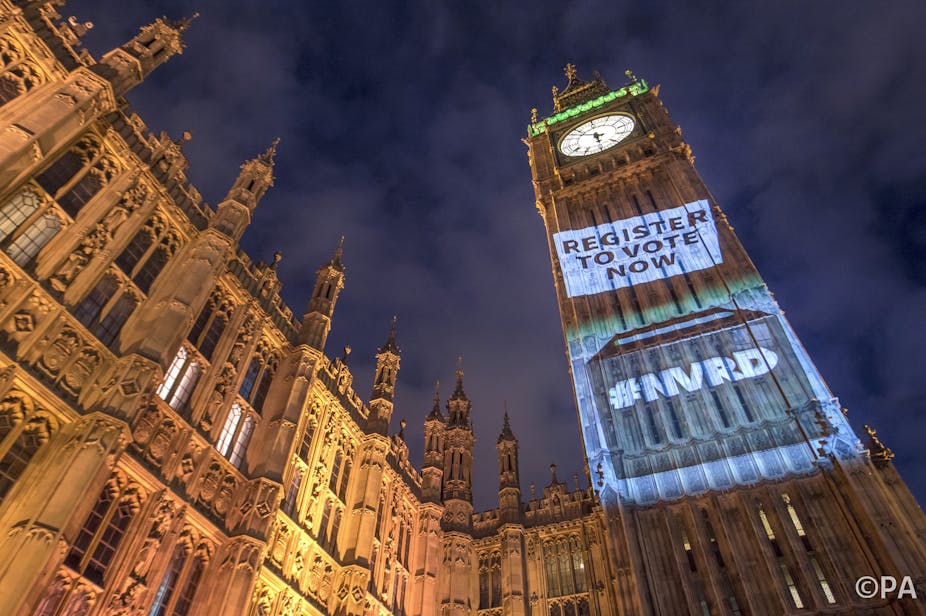With a little more than two months to go before polling day, it looks as though voter turnout in 2015 will be high. There has been some concern that because the 2015 campaign is very long – and has been effectively running since January – voters will get bored and switch off. The evidence does not support this argument though.
The chart below shows responses to a question about the willingness of citizens to vote in a general election, asked every month in the Essex Continuous Monitoring Survey since 2004. The question is:
Using a scale from 0 to 10, where 10 means very likely and 0 means very unlikely, how likely is it that you will vote in the next general election?
The average scores for Britain as a whole have been recorded up to February 2015.

Two things stand out here. First, there is an upsurge in the likelihood that people will vote during the run-up to general elections. This happened in 2005, when the actual turnout was 61%, and again in 2010, when the turnout was 65%.
The second and most striking finding is that the voting intention measure has been trending upwards since around the spring of 2014. By the end of that year it had reached an all-time high over the ten years of surveys. This suggests that the turnout in the May general election of this year is likely to be well up on the previous two elections.
Two-pronged attack
The official campaign can be seen as divided in two. There is the air war – run from the party headquarters and in the media and prominently featuring the party leaders – and the ground war – which sees party activists canvassing voters and delivering leaflets, talking to the local media and generally trying to mobilise their own supporters.
The traditional air war is characterised by carefully choreographed speeches and photo opportunities which hardly feature any “real” people. This side of the campaign was given a huge boost in 2010 by the three leader debates and there is evidence to suggest that this important innovation played a big part in the turnout for that election.

So far in 2015, the air war – at least the one being fought by the three major parties – looks rather dated. It has little in the way of a buzz about it and has largely involved a ratcheting up of the House of Commons cross-party insult game exemplified by the weekly Prime Minister’s Questions.
Voters dislike this type of argy bargy politics and while the party leaders recognise that, they can’t seem to restrain themselves once they get into the Commons chamber. Moreover, there is still wrangling over the leader debates in the election and a chance that they might not happen. So if this aspect of the campaign is not particularly inspiring why are we seeing an upsurge in voters’ willingness to turnout?
For a start, it has a lot to do with the wider choice that voters are being given in this election.
There is a big ideological division between Labour and the Conservatives when it comes to austerity policies in the post-election period, for a start. Then there are the upstarts. The Greens have developed into an insurgent party of the left, calling for policies such as the living wage and the renationalisation of railway franchises. Similarly, many Scots think that the Scottish National Party is more likely to protect the social democratic state than Labour and have switched allegiance in large numbers.
Of course, the rise of UKIP offers yet more ideological diversity. Nigel Farage’s party constitutes a real threat to the other parties.
So despite the disappointment of the air war so far, ideological diversity is likely to stimulate turnout. Give voters a wider choice and you’ll see more of them exercising it.
Under the radar
While the long campaign can make life difficult at the top, it can also make the ground war a powerful battleground. This is likely to have a positive effect on voter turnout.

The ground war largely takes place under the radar, since it involves getting party activists and other volunteers to bring the campaign to the streets. The advantage of a long campaign is that it gives the parties extra time to mobilise their resources. Canvassing, in particular, can be quite effective since it puts a face to a party and gives voters a chance to interact with real people instead of just being the passive consumers of messages from party leaders.
We still have a couple of months to go before polling day, so we will be able to track voter intentions further, but at this stage it looks like an election with a turnout well above that observed in recent elections – and that can only be good for democracy.

